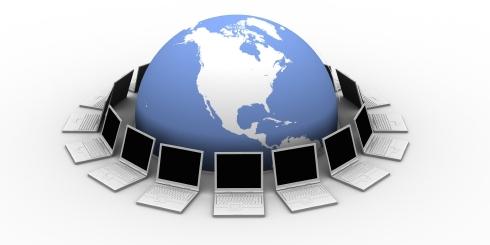
On the Social Implications of Invisibility: The iMac G5 and the Effacement of the Technological Object
Many people use a Macintosh computer and choose to do so because of their hip, popular designs. The look of Apple's competitively priced desktop, the iMac G5, exemplifies the company's attempts to beautify digital technology with a sleek shape that inserts the computer into the monitor. Yet the tool's attractive appearance also disguises socially problematic aspects of the production and disposal of new media devices.
The Apple Corporation's current advertising campaign presents their products as culturally sophisticated, positioning itself as a central player in the burgeoning market of lifestyle-based digital media. Relatively inexpensive desktop computers such as the iMac G5 come equipped with an array of software and hardware accoutrements designed to create everything from home movies to the twenty-first century equivalent of a jukebox.
The increasing integration of these machines into our everyday lives led two researchers from the University of Iowa to consider how the shape of Apple Computers reflects our greater reliance on technology to serve our communication needs. Peter D. Schaefer, a doctoral student in Communication Studies, and Meenakshi Gigi Durahm, an associate professor of Journalism and Mass Communication, conducted an analysis of the design of Apple's iMac product line that revealed a gradual elimination of the physical presence of these objects and the ramifications thereof. The iMac G5 appears as a flat-screen monitor without any cumbersome, boxy towers typical of earlier desktop computers. The researchers looked to the marketing of the iMac along with reviews of the machine in the popular press to see how the shape of this technology connects to the business structure of Apple Computer, suggesting political and social resonances with the technology and its use.
Apple exemplifies the diffused production typical of contemporary global markets as a transnational corporation with numerous factories throughout the world with business hubs in many foreign capitals. The iMac G5's shape can be seen to reflect the company's organization. Its austere design disguises the hard drive, microprocessor, battery, and numerous other mechanical elements necessary for computation. The places where Apple produces iMacs are removed from the places where people use them, tucked away in underprivileged areas of the globe. As a popular desktop computer, the iMac's design suggests the ways the technology orients users away from understanding the socioeconomic inequalities that make possible the easy and comfortable lifestyle enhancements these tools provide.
The design of Apple's iMacs have become more and more invisible with each incarnation. The iMac G3 resembled a rectangular monitor that was not that different from the classic 1984 Mac design. The iMac G4 looked more like a lamp, with the mechanical parts of the computer compressed in the stand on which the monitor rested. Now, the iMac G5 doesn't even look like a desktop computer by 20th century standards. It is merely a monitor without anything to show its mechanical nature. By designing technology to look natural, users are less likely to take into account the people affected by the production, distribution, and disposal of the circuitry. Laborers in so-called developing countries work to produce new technology, yet these workers receive relatively low wages, limited or no benefits, and have a high frequency of temporary employment. Materials such as lead and mercury can leech out of disposed computers, leading to dangerous circumstances for those exposed. Access to digital technology remains uneven in ways that align with social stratification. These persistent problems demonstrate that we still need to take critical steps to alleviate imbalances of power that permeate all aspects of communication technology.
Apple's sleek design for the iMac blends with the environment, thereby disorienting users from the social forces that are an important part of these tools. Computers tacitly support users' reliance on technological expertise, thereby strengthening systems of powerful authority that are tied to forms of economic and political domination, and the naturalization of computing technology serves to obscure such connections. Computers can also be instruments of surveillance, both government and corporate. Computers are a crucial way through which people communicate with each other, but this analysis suggests that one must pay attention to the design of media devices, so as to be conscientious consumers and users. There remains the responsibility to redress the inequalities that structure the economy of tools used for communication. Rather than take a stance against technology, these machines must be embraced as useful resources for bringing people together, but not at other people's expense. We cannot revert to a pre-technological past, since that would undermine that which makes us human. Thus, users of communication devices must hold fast to the progressive possibilities of technology like the iMac G5 but realize and think through how its design reflects social problems connected to their material circumstances, with the goal of confronting and resolving such inequities.

